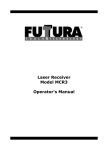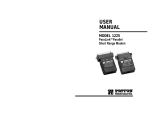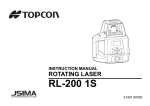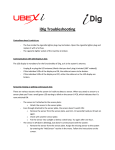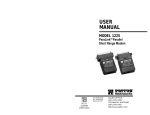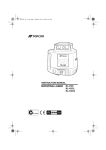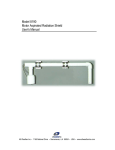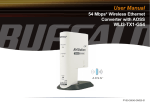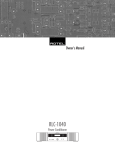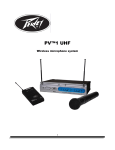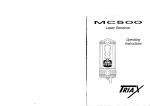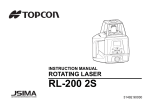Download Users Manua
Transcript
Laser Receiver Model MCR2+ Operator's Manual Thank you for purchasing a Futtura product. Your receiver is a premium quality tool that has been designed and manufactured to provide years of precise and reliable performance. The system has been specifically designed for use in harsh construction environments. This manual is an important part of your purchase as it will familiarize you with the unit and explain the numerous features that have been designed into it. Please read this manual thoroughly before using your receiver. Please contact your dealer should you have questions regarding specific applications or if you require additional information. Please record your product information below. This will assist you if there are any questions regarding warranty or service. PRODUCT: _______________________ SERIAL NUMBER: _______________________ PRODUCT: _______________________ SERIAL NUMBER: _______________________ DATE OF PURCHASE: _______________________ PURCHASED FROM: _______________________ PHONE: _______________________ Contents Laser Receiver Safety ............................................................................................2 System Description .......................................................................3 Controls and Displays ...................................................................4 Battery Installation / Charging .......................................................6 Operation .......................................................................................8 Installation and Set-Up ................................................................13 Specifications ..............................................................................18 Warranty ......................................................................................19 Maintenance and Care ................................................................19 010806 Rev C Safety Meaning of Symbols: WARNING: Indicates a potential hazardous situation, which could result in death or serious injury. CAUTION: Indicates a potentially hazardous situation, which could result in a minor or moderate injury and/or material, financial, or environmental damage. NOTE: Important information to enable the product to be used in a correct and efficient manner unrelated to safety. The user of this product is expected to follow all operating and safety instructions of this manual and of the machinery operator's manual. Perform periodic checks of the product's performance. The manufacturer or its representatives assume no responsibility for results of the use of this product including any direct, indirect, consequential damage, and loss of profits. Check your work frequently. WARNING: When working near construction or agricultural machinery, follow all safety precautions as described in the machinery's user manual. WARNING: When excavating, follow all excavation and trench safety regulations and practices CAUTION: Be aware of all overhead obstructions and electrical power lines. The receiver and mast may be higher than the machinery. Remove when transporting machinery. CAUTION: Do not disassemble any part of the receiver other than to replace batteries. The receiver is to be serviced by authorized service personnel only. 2 System Description The laser receiver is a rugged, multipurpose, electronic receiver that detects laser light generated by rotating laser transmitters. The unit is designed to work with nearly all makes and models of rotating lasers and will detect both visible and invisible beams. When installed, the operator is given visual indication of the reference plane of laser light’s position relative to the cutting edge of the machine. The receiver can also be installed with a control box for automatic control on certain grading machines. The features and versatility built into the receiver provide a product that can increase the utilization and productivity of many different types of construction and agricultural machinery. The operator can customize the settings of the reeiver to meet job site requirements. Settings are provided for adjusting on-grade deadband or accuracy, location of "on-grade" for grading or excavation, plumb indication and accuracy, blade tilt indication and accuracy, LED display for bright or dim conditions, and a laser out-of-level warning. The super-bright, built-in LED grade display provides up to 7 channels of grade elevation position, plus high and low lost beam indications that can be turned off if desired. Status LED's provide five channels of blade tilt indication and low battery indication in addition to selection status. A tough sealed waterproof housing is designed to work in the tough machine mounted environment. The electronics are isolated from the rest of the unit by internal rubber shock-mounts, protecting the unit from shock and vibration damage. 3 Controls and Displays 1. Aluminum cast upper and lower housings. 2. Polycarbonate housing - protects the electronics. 1 3. Receiving Window - four sets of photocells spaced to allow 360 degree reception. 2 4. Super-bright grade display LED's are highly visible - graphically displays the blade or bucket position. 3 5. Power Switch turns the unit on and off. 4 6. LED status indicators for on-grade location, deadband selection, and low battery warning. Also functions as blade tilt indicator. 5 6 7 7. Touchpanel Switches - Primary functions select blade tilt display, ongrade location, on-grade deadband (accuracy), and display brightness. Secondary functions select blade tilt accuracy, plumb indication accuracy, laser beam averaging, and laser outof-level warning. 8 9 8. Mounting Knobs - large, front facing knobs attached to stainless steel clamps allow for quick and easy installation to mast or magnetic mount. 9. Access screws - allows easy access to battery compartment for replacement of batteries. 10. Accessory Connector and Dust Cap - connector accepts the cable connector to the optional remote display, machine power cable, or automatic control box. Connector also accepts Ni-MH battery charger. Dust cap helps keep the connector clean. 4 10 Controls and Displays LED Status Indicators 5 Light Blade Tilt Indication On-Grade Location Indicators Center On-Grade, Grading Low Battery Indicator Combination Offset On-Grade, Excavating, Plumb On Fine Deadband Deadband (Accuracy) Indicators Standard Deadband Wide Deadband Touchpanel Switches Secondary Functions Blade Tilt Accuracy Blade Tilt Indication Plumb Indication Accuracy Laser Beam Averaging On-Grade Location, Plumb On / Off Deadband (Accuracy) Selection Primary Functions 5 Laser Out-of-Level Display Brightness Selection Battery Installation / Charging Battery Installation: Remove the BULLSEYE from its carrying case. Hold the unit so the accessory connector is pointing upwards. Remove the dust cap from the accessory connector. Loosen the two thumb screws and remove the battery access cover. Install four “C” cell batteries as shown on the label diagram inside the battery compartment noting the (+) and (-) terminals. Battery installation diagram / Serial number label Replace the battery access cover. Firmly tighten the two thumbscrews. Ensure the battery access cover is aligned and fully engaged into the battery housing. Use a screwdriver if necessary. Replace the accessory connector dust cap. Nickel Metal Hydride (Ni-MH) Batteries: Batteries are initially shipped fully charged but the charge may decrease over time prior to first use. They may require 2 or 3 charging cycles to obtain maximum battery life. To charge, remove the dust cap from the accessory connector. Insert the cannon adapter into the receiver accessory connector aligning the slot and connector key. Insert the charger female barrel connector into the cannon adapter. Assure the proper AC prongs are on the charger. To change the prong configuration, press the tab release in the arrow direction and remove the existing prong adapter. Insert proper adapter and release the tab. Plug the charger into an appropriate outlet. Do not operate the receiver when it is charging. Cannon Adapter Prongs Tab Release Charger The batteries may also be charged with a 12-volt auto lighter adapter. 6 Battery Installation / Charging Built-in overcharging protection prevents damage if the unit is left on charge after being fully charged. There is also protection to prevent charging alkaline batteries. CAUTION: Do not attempt to charge alkaline or other disposable batteries. NOTE: Do not charge Ni-MH batteries when ambient temperature exceeds 113° F (45° C) or is less than 32° F (0° C). The rechargeable battery electronics include a charge status and charge error indicator located on the back of the housing. Charge Status Indicator: The LED will remain solid when the unit is charging. The LED will blink when fully charged. When charged, unplug the charger from the outlet and remove the cannon adapter from the accessory connector. Charge Error Indicator: If the batteries seem to be in a totally drained state initially, the charge circuit will try to gradually charge the batteries. If charging is unsuccessful after approximately 20 minutes, the LED will turn on solid indicating an error with the internal battery connection, improper battery insertion, the wrong type of battery, or a dead battery cell. A blinking charge error LED indicates the unit is too hot or too cold to charge. Charging will automatically start when the temperature is within the above noted ranges. Charge Error Indicator Solid - Battery Problems Blinking - Temperature out of limits Charge Status Indicator Solid - Charging Blinking - Charging Complete (Located on lower rear of polycarbonate housing) Battery Replacement - Remove dust cap, loosen thumbscrews, and remove battery access cover. Remove old batteries. Install new batteries as described on previous page. Refer to your local requirements for the proper disposal of batteries. 7 Operation Power: Press the power switch on the touch panel to turn the unit on. All the LED's will light briefly, then each LED grade display row will turn on then turn off from top to bottom. Then each status indicator will turn on and off. The current deadband status and on grade location will momentarily display. If the receiver is out of a laser beam, the center green LED will flash to confirm power is on. If the receiver is in a laser beam, a corresponding LED grade display will be indicated. While the unit is on, pressing and holding the power switch and then pressing the touch panel switches will activate secondary functions which are indicated by the symbols above the switch. To turn the power off, press and hold the power key until the LED's are lit, then release. Settings will be retained the next time the unit is turned on. Switch Functions Tilt Indicator: Press the tilt indication switch to turn the display on or off. The LED status indicators will display a rolling sequence. When the function is turned on, the LED's will sequence from the center outward. When turned off, the LED's will sequence from the outer LED's inward. When on, the LED's will provide 5 channels of tilt indication. The center LED will be on when the blade or dipperstick is within the tilt accuracy setting. The right side will light when the operator's right side of the blade or dipperstick is low. The left side will light when the left side is low. Initially the blade tilt indication is set to level. It can be set to match the current blade slope. See installation notes on Page 15. Tilt Indicator Accuracy: Accuracy can be set to fine, standard or wide. Press and hold the power switch and then press the tilt indicator switch to select and cycle the tilt accuracy function. The current selection will flash rapidly. Pressing this switch combination while the status LED is flashing will change the current selection, sequencing from fine to standard to wide to fine, etc. Fine ± 0.5º Standard ± 1.5º 8 Wide ± 2.5º Operation Center / Offset On-Grade Location Switch: Center on-grade is selected for typical grading or cut/fill operations. This mode indicates an equal amount of grade information above and below on-grade. Offset on-grade is selected for typical excavation operations. This excavation mode gives more information and a larger display area above on-grade. This mode also enables the plumb indication which shows the operator when the mast and receiver are perpendicular to the ground (plumb) for more accurate grade readings. Each selection uses a different array of LED's Pressing the switch once flashes the LED of the current on-grade location. Pressing the switch again while the LED is flashing changes the selection. Slow Flashing Fast Flashing Center On-grade Selected, Plumb Off Center On-grade LED's used Offset On-grade Selected, Plumb On Offset On-grade LED's used Solid LED's Plumb Indication: The plumb indication shows when the mast and receiver are perpendicular to the ground or beyond the selected deadband range. The grade display LED's will flash quickly when the boom is extended, and will flash slowly when the boom is retracted beyond this range. The LED grade display is solid when the boom is within the plumb range setting. Plumb Indication Accuracy: Accuracy can be set to fine, standard or wide. Press and hold the power switch and then press the on-grade location switch to select and cycle the plumb accuracy function. The current selection will flash rapidly. Pressing this switch combination while the status LED is activated will change the current selection, sequencing from fine to standard to wide to fine, etc. Fine ± 0.5º Standard ± 1.5º 9 Wide ± 2.5º Operation Deadband (Accuracy) Switch: Each on-grade location has three deadband or accuracy selections - fine, standard, and wide. The center or grading deadbands are smaller than the offset or excavating deadbands. Pressing the switch once flashes the status LED of the current selection. Pressing the switch again while the status LED is activated changes the selection, sequencing from fine to standard to wide to fine, etc. Fine Standard Wide Center On-Grade (Grading) 5 mm (3/16 in) 10 mm (3/8 in) 20 mm (3/4 in) Offset On-Grade (Excavating) 12 mm (1/2 in) 25 mm (1.0 in) 50 mm (2.0 in) Laser Beam Averaging: The secondary function for the Deadband Switch is laser beam averaging. The laser beam averaging function senses the laser strikes and applies the highest level of averaging appropriate for the laser rotation speed. This may stabilize the LED grade display if the laser set-up is unstable due to windy conditions or long range applications. The factory default setting is Laser Beam Averaging ON. The receiver can be set for no averaging. In this mode the receiver processes and displays every single laser strike. To change between the two modes, press and hold the power switch and then press and release the deadband switch. The outer green on-grade LED's will flash to indicate averaging selection. When the center LED is on, averaging is on. When the center LED is off, averaging is off. Pressing this switch combination while the LED's are activated will change the current selection between on and off. Averaging ON Averaging OFF 10 Operation Display Brightness Selection: The brightness switch controls the LED grade display and blade tilt display brightness. Bright and Dim are the selection options. Use Bright for daytime operation if necessary and Dim for lower light conditions. Operating with Display Dim selected will extend battery life. When the brightness switch is pressed and the receiver is out of the laser beam, the LED's will display a circle with the current setting. Press the brightness switch again while the LED's are activated to change the setting. The LED's will then display the new setting. When the receiver is in the laser beam, simply press the brightness switch and the setting will change. Out Of Level Warning: The secondary function for the Brightness Switch is laser Out of Level (OOL) Warning. The Out of Level Warning is used with certain lasers that have the ability to indicate they are out of level by changing their rotation speed. The factory default setting is Laser Out of Level Warning off. To activate the laser OOL Warning, turn the receiver on. Press and hold the power switch and then press and release the brightness switch. If the center green LED is not lit, the OOL Warning is off. Pressing the power / brightness switch combination again while the "X" pattern is activated will turn the warning on. The center green LED will come on to confirm the OOL Warning is on. Pressing the switch combination again while the "X" pattern is activated will toggle between on and off. When the warning is turned on and the laser drops to 140 RPM, a flashing "X" will appear on the display to let the machine operator know the laser is out of level. Laser Out of Level OFF Laser Out of Level ON 11 Operation Out of Beam Indication. The receiver has an Out Of Beam (OOB) indication that can be turned on or off. When it is on, the LED grade display will indicate if the receiver has moved beyond the vertical laser reception range. A sequence of LED's will indicate which direction to move the blade or cutting edge to pick up the laser beam. The sequence will indicate to move the edge down if it is raised above the beam or to move the edge up if it is lowered below the beam. The sequence will stop as soon as a laser signal is received. Otherwise it will shut off after two minutes. Sequence to raise implement Sequence to lower implement Out of Beam Indication ON The factory default setting is Out of Beam Indication on. To change the indication setting, press the two outside switches (Blade Tilt and Display Brightness) at the same time. The LED display will show a sequence inward toward on-grade when the indication is on or outward from on-grade to confirm the indication is off. Low Battery Warning. The receiver has a low battery warning LED combination that is used when batteries are installed. During normal operation with good batteries, the LED's are off. When the batteries become low, the LED's will begin to flash as a warning. The unit will operate as normal, with approximately 90 minutes of battery life remaining. When the batteries are too low for proper operation, the LED's will be on continuously and the four corner grade display LED's will flash. The unit will no longer receive laser signals and the batteries must be replaced (or recharged if using rechargeable batteries). The warning does not operate when the receiver is connected to machine power via a power cable. 12 Installation - General Set up the laser in a convenient, safe location. Please refer to your laser operator's manual. Ensure the laser is on a stable tripod. On windy, gusty days it may be advisable to tie down or weigh down the tripod to make the laser beam more stable. Operating distances are dependent upon the rotating laser power. The receiver can pick up the beam from all directions (360°), but still requires a clear line of sight between the laser and receiver. If your laser has selectable rotation speeds, select a high rotation speed. The receiver can process speeds up to 1200 RPM. To mount the receiver on a mast, turn both the top and bottom knobs counterclockwise until the mounting clamps in back open enough to fit around the mounting mast. Place the receiver on the mast. The receiver will mount to round tubing that has a 42 to 50 mm (1.66" to 2.00") outside diameter or to 38 mm (1-1/2") square tubing. Turn the knobs clockwise to tighten. Loosen the two clamps to remove the receiver from the mast. WARNING: Follow all safety precautions per the machines operator's manual and follow all excavation and trench safety requirements and practices. The blade tilt and plumb indications are measured inside the receiver. The blade tilt indicates side-toside position. Plumb indicates front-to-back position. Masts and receivers must be properly aligned to the machinery for accurate indications. Plumb axis rotation Assure dozer masts are aligned vertical both frontto-back and side-to-side with the blade when the blade is in its normal operating position. For excavation, typically the mast points towards the bucket teeth. Additional installation details can be found on page 15. Typical dozer installation Typical excavator installation 13 Blade tilt axis rotation Installation - Grading Laser Center On-grade Finished Elevation Benchmark Position the machine so the blade is set to the desired finished elevation, typically on a benchmark or hub stake. Set the laser up in an appropriate location for receiver visibility and efficient machine operation and turn it on. Turn the receiver on, select center on-grade (grading mode) and select the smallest deadband. Mount the receiver to the mast. Slide the receiver up or down until on-grade is indicated. It may be necessary to adjust the height of the laser. Alternatively, if the height of instrument (laser beam) to finished elevation length is known, the receiver can be set by measuring this distance from the cutting edge of the blade to the center on-grade mark on the back of the receiver label. Face the LED grade display toward the operator and tighten the clamps. Select the desired deadband and brightness. Select optional blade tilt display and blade tilt accuracy if desired. The LED grade display will direct the operator which way to move the blade using the machine's controls to maintain an "on-grade" reading. Make a sample pass with the blade "on-grade" and check to ensure the elevation is correct. Check blade tilt also if blade tilt indication is selected. 14 Installation - Slope Matching The blade tilt indicator can be nulled or set to zero at a blade slope other than level. This is used for matching an existing slope or setting the blade to a predetermined slope. The factory default setting of the blade tilt indicator is level. To set the blade tilt indicator at a slope other than level, position the blade at the desired slope. Ensure the receiver is aligned properly side to side and front to back with the blade. With the receiver on, press and hold the power switch and immediately press and hold both the blade tilt switch and the display brightness switch. Continue holding all three switches until a "0" symbol followed by a "Y" symbol is briefly displayed. The blade slope is now nulled at the existing slope. "Y" symbol "O" symbol To reset the blade tilt indication back to level, position the blade to level and check with a four-foot level or other method. Repeat the above calibration procedure with the blade level. This procedure may also be used to correct the display when a mast is not aligned properly to the blade. 15 Installation - Excavating When using on an excavator or backhoe, the dipperstick should be vertical or near vertical and the bucket positioned so it can easily be repeated each time a grade reading is taken. The bucket can be fully extended or curled as long as it is consistent when grade readings are taken. The receiver can be set-up in the trench or out of the trench if the cut elevation can be determined. In Trench Set-Up Position the machine and dig to the desired finished elevation. Position the bucket in the grade checking position at the finished elevation. Set the laser up in an appropriate location for receiver visibility and efficient machine operation and turn it on. Mount the mast on the side of the dipper arm. Point the mast at the bucket teeth as illustrated if checking grade with the bucket fully extended. (If checking grade with the bucket curled or other position, point the mast to the point of the bucket that makes contact with the ground.) Turn the receiver on and select the offset on-grade and the smallest deadband. Place the receiver on the mast, tighten, and adjust the dipper arm so the receiver is within the plumb range - solid LED's. Adjust the plumb indication accuracy if desired. Loosen the receiver and slide it up or down to get an on-grade display, then tighten. Select the desired deadband and begin to excavate. Take grade readings with the bucket in the grade checking position and the grade display LED's solid. Take a sample reading with the bucket "on-grade" and check to ensure the elevation is correct. 16 Installation - Excavating Out of Trench Set-Up Set the laser up in an appropriate location for receiver visibility and efficient machine operation and turn it on. Place the bucket in the grade checking position and situate the machine so a measurement can safely be obtained on the dipper arm. The dipper arm may be set more horizontal to the ground for convenient measurements if necessary. Determine the distance from the laser to the bottom of the trench (L). This is the set-up length. The length is the height of the instrument (HI) plus the depth of cut from the benchmark to the bottom of the trench (C). Mount the mast on the side of the dipper arm. Point the mast at the bucket teeth as illustrated if checking grade with the bucket fully extended. (If checking grade with the bucket curled or other position, point the mast to the point of the bucket that makes contact with the ground.) Position the receiver so the set-up length (L) is the distance from the bucket ground contact point to the offset on-grade symbol on the back label. (Set up to center on-grade symbol if center on-grade will be used). Turn the receiver on and select offset on-grade and the desired deadband. Adjust the plumb indication accuracy if desired. (Select center on-grade if set to center symbol). Begin to excavate. Take grade readings with the bucket in the grade checking position and the grade display LED's solid. Take a sample reading with the bucket "on-grade" and check to ensure the elevation is correct. 17 Specifications Beam Reception Operating Range Laser RPM Vertical Reception Accuracy Center On-Grade (Grading) Offset On-Grade (Excavation) Blade Tilt Accuracy Plumb Swing Accuracy Display Output Power Options Battery Life - Alkaline (Continuous in beam) Battery Life - Ni-MH (Continuous in beam) Battery Recharge Time Automatic Shut Off Out of Beam Indication Remote Display Option Automatic Control Option Dimensions Mounting Pipe Operating Temperature 360 degrees Over 460 m (1500 ft.) radius, laser dependent Minimum - 105 ; Maximum - 1200 171 mm (6.75") Fine: 5 mm (3/16") Standard: 10 mm (3/8") Wide: 20 mm (3/4") Fine: 12 mm (1/2") Standard: 25 mm (1.0") Wide: 50 mm (2.0") ± 0.5°, ± 1.5°, ± 2.5° ± 0.5°, ± 1.5°, ± 2.5° Bright or Dim Alkaline - 4 x "C" Cell - Standard Nickel Metal Hydride - 4 x "C" Cell Power Cable - 10-30 VDC 60 Hours, Display Dim 45 Hours, Display Bright 45 Hours, Display Dim 30 Hours, Display Bright 3 - 4 hours 75 minutes with no laser beam High and Low, Selectable on or off Yes Yes 343 x 142 x 149 mm (LxWxD) (13.50" x 5.58" x 5.88") 42 mm to 50 mm O.D. round tube (1.66" to 2.00") and 1 1/2" (38 mm) square tube -20° to +60° C (-4° F to 140° F) 18 Warranty Receivers are warranted to be free of defects in material and workmanship for a period of two years. This warranty period is twenty-four months from the date the product is delivered from the dealer to the purchaser or is put into service as a demonstration or rental unit. Please retain your warranty information and proof of purchase. Any evidence of abuse, misuse, alteration, accident or negligent use or an attempt to repair products by unauthorized personnel or with parts other than those provided by the manufacturer automatically voids the warranty. The user of the product is expected to follow all operating instructions, periodically checking the instrument and the work as it progresses. The manufacturer's liability under this warranty is limited to repairing or replacing any product returned to an authorized service center for that purpose. The foregoing states the entire liability of the manufacturer regarding the purchase and use of its product and they shall not be held responsible for any consequential loss or damage of any kind. This warranty is in lieu of all other warranties, expressed or implied, and constitutes all of the manufacturer's liability with respect to merchandise sold by it. Maintenance and Care Your Laser Receiver was shipped in a moisture resistant foam padded carrying case. If the unit is transported from job to job inside its factory-provided case and normal instrument precautions are followed, the unit will provide many years of service. Do not wipe dust or dirt off the laser receiver with a dry cloth as scratching could occur, possibly damaging these surfaces. Use only a good quality glass cleaner with a soft cloth on all external window surfaces. If these surfaces have hardened concrete or other materials on them, take the unit to your Authorized Service Center for cleaning. If the system will not be used for a 30 day period or more, it is recommended to remove the batteries from the receiver. Space is provided in the carrying case for the storage of batteries. 19 P/N 010751-15 Rev C Manual

























